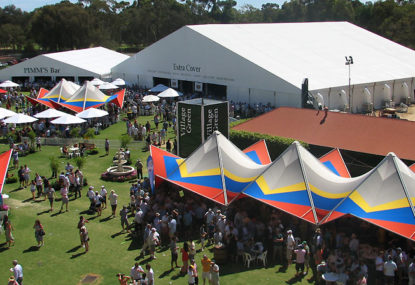It was perhaps the only question with no obvious answer coming into the Ashes series. While the four other grounds were all known quantities – or known-ish, in the case of Melbourne – the redevelopment of the Adelaide Oval meant that only question marks remained.
The second Test will mark the first sightings of the new-look stadium-inspired redevelopment for most of us, and indeed, for most if not all of the players, too.
Though South Australians have been crying out for a new AFL-capable stadium in or near the city for years, cricket diehards have long baulked at the idea of their beautiful ground looking anything other than the Adelaide Oval vista we all know and love.
The SACA Members’ decision in 2011 to accept the development proposals and turn their idyllic cricket ground into said AFL-capable stadium in or near the city cannot have been an easy one.
On that regard I will be particularly grateful, when Ashes hostilities resume in Adelaide next week, that I was able to see the ‘old ground’ in the flesh three summers ago, even if it was the most modern incarnation of the old ground at the time.
And she was as beautiful as I hoped she would be.
Test match week in Adelaide takes on a real carnival atmosphere, with people coming to town from all over Australia.
The back of the Member’s Stand transforms into a kaleidoscope of coloured marquees and shade sails as members from far and wide mingle and eat and laugh and drink, and quite likely, not see a ball bowled live for five days.
On tour at the time, I wrote that it “has a real country picnic races feel about it. The frocks come out, the spray-tans come with them, and it’s a world away from the Test match on the eastern side of the stand.”
And it remained the best media catering I experienced over the course of the 2010/2011 Ashes Series, with lunch each day accompanied by local wines, beers, seafood, and numerous other delicacies that their producers were only too happy for we hacks to sample in volume.
But what of Adelaide Oval, circa 2013?
With the stadium encompassing all but the northern hill and scoreboard area at the St Peter’s Cathedral end, and the flattest of flat batsmen’s paradise wickets replaced by one of these new-fangled drop-in abominations, what sort of contest can we expect next week?
Well, if the two Sheffield Shield games played on the new wicket and outfield are anything to go by, the answer to that question is “the same as it ever was”.
When young no.3 bat Travis Head was out for 98, South Australia was 3/473 in their first innings of the first Shield game played on the new wicket.
And that was in reply to Western Australia’s 434.
SA would eventually be bowled out for 601 in their first innings, with 1237 runs made in three innings for the match, which included Phil Hughes’ 204, Michael Klinger’s 125, Marcus North’s 110, nineties to Head and Western Australia tweaker Ashton Agar, and three other scores above 65.
Only 23 wickets fell across the four days, with eleven of them falling to specialist spinners.
In the second Shield game completed on Monday just gone, another 1286 runs were scored across four innings in the SA-Tasmania match, for the loss of 32 wickets.
As a former batsman, it still sounds unthreateningly and wonderfully bloody flat!
Tasmanian opener Jordan Silk and former Test opener Ed Cowan both made hundreds, Head made another 98, cruelly, and there were another six fifties and a 49 made for the match.
Seventeen of the 32 wickets fell to spin, including a ‘5fer’ for Xavier Doherty, of all bowlers.
Interestingly, this spin trend is not expected to continue in the Second Test.
Adelaide Oval curator Damien Hough told the The Daily Telegraph this week that he’s expecting the new deck to favour the quicks, mainly, and that Graeme Swann shouldn’t be counting on repeat conditions to 2010, where his second innings 5/91 bowled England to an innings and 71 run-victory.
“We are planning to have something there early. From our end we are trying to get as much pace and bounce as we can,” Hough was quoted as saying.
“We will look at leaving a little grass on it just to assist with making it a competitive wicket.”
The new wicket square was grown in the Adelaide Oval No.2 nursery next door, and thus it was been exposed to the same elements, rather than shipped in from a distance as was the case in the early years of the MCG ‘drop-in’.
Hough has also suggested that the wicket also won’t produce the big cracks it once did.
The Santa Ana grass on the drop-in square is the same as that used on the old Adelaide Oval square for the past ten years or so, but the compacted nature of the drop-in construction means there is unlikely to be the same deterioration over the five days as would be the case with a traditional cricket wicket.
Happily, Hough said the players in the SA-Tasmania Shield game were happy with the wicket bounce, and that there were no signs of inconsistent or ‘tennis ball’ bounce. The outfield surface also rated very highly.
It all seems to be pointing to a pretty true cricket wicket.
Certainly, the batsmen can expect some happy times out in the middle, but it does sound like the bowlers shouldn’t be too disheartened.
It will be interesting to see how green an appearance the wicket has on the first morning next Thursday, and for how long the purported pace and bounce lasts.
Obviously, from the perspective of the Australian quicks, they’ll be hoping the rumoured conditions eventuate.
Another good week in Adelaide, and they could be heading to Perth three days later in a previously unthinkable 2-0 position in the series.





























































































